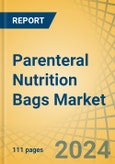Following a comprehensive primary and secondary study and an in-depth analysis of the market scenario, this report provides the key drivers, restraints, challenges, and opportunities of the industry. This market is driven by the rising global prevalence of malnutrition, the large number of premature births, and the increasing incidence of metabolic disorders.
Furthermore, the growing adoption of home healthcare, the rising global geriatric population, and emerging economies provide significant growth opportunities for this market. However, concerns over the infection risks associated with parenteral nutrition restrain the growth of this market. The lack of awareness regarding parenteral nutrition in developing countries is a major challenge impacting the growth of the parenteral nutrition bags market.
Among chamber types, in 2024, the single-chamber parenteral nutrition bags segment is expected to account for the largest share of the parenteral nutrition bags market. Single-chamber parenteral nutrition bags are designed to compound and store a comprehensive blend of nutritional solutions, including electrolytes, amino acids, lipids, vitamins, carbohydrates, and trace elements within a single compartment for parenteral administration. The large share of the segment is attributed to the wide availability of single-chamber empty bags, high rate of prescription for single-chamber nutrition bags, decreased risk of infection, less prescription & administration errors, and cost-effectiveness as compared to dual or multi-chambered bags.
Among consumers, in 2024, the adults segment is expected to account for the largest share of the parenteral nutrition bags market. The rising number of surgeries, rising hospitalization rates, the growth of the geriatric population, and the increasing prevalence of gastrointestinal disorders among adults are factors supporting the largest share of the market. For instance, in 2020, the Rome Foundation of Global Epidemiology Study revealed that 40% of people worldwide suffer from diseases of the gut-brain interaction (DGBIs), such as irritable bowel syndrome, functional dyspepsia, and functional abdominal pain syndrome, among others. Most of these patients would require parenteral nutrition bags for the intake of the required nutrition.
Among end users, in 2024, the healthcare facilities segment is expected to account for the largest share of the parenteral nutrition bags market. The large market share of this segment is attributed to factors such as a large number of patients visiting hospitals and clinics for disease diagnosis and treatment, growing disease burden, an associated rise in the rates of prescription for parenteral nutrition, and the presence of advanced compounding equipment in the hospital associated compounding pharmacies.
An in-depth analysis of the geographical scenario of the global parenteral nutrition bags market provides detailed qualitative and quantitative insights for the five major geographies: North America, Europe, Asia-Pacific, Latin America, and the Middle East & Africa. In 2024, North America is expected to account for the largest share of the global parenteral nutrition bags market, followed by Europe, Asia-Pacific, Latin America, and the Middle East & Africa. This growth is primarily driven by the growing demand for parenteral nutrition due to the prevalence of chronic & infectious diseases, the rising number of premature births, and the growing adoption of home healthcare settings. For instance, according to the World Health Organization (WHO), in 2020, approximately 13.4 million babies were born preterm (before the completion of 37 weeks of gestation). Preterm babies often require nutrients that need to be provided parenterally since oral nutrition is not possible, therefore increasing the demand for parenteral nutrition and supporting the growth of the market.
The key players operating in the global parenteral nutrition bags market are B. Braun SE (Germany), Baxter International, Inc. (U.S.), Fresenius Kabi AG (Germany), GVS S,p.A. (Italy), Grifols, S.A. (Spain), Technolflex (France), RENOLIT Healthcare (Germany), Valmed s.r.l (Italy), HEMEDIS GmbH (Germany), INFRA Srl (Italy), Beijing L&Z Medical Technology Development Co., Ltd.(China), Boen Healthcare Co., Ltd. (China), AdvaCare Pharma (U.S.), and Diffuplast S.r.l. (Italy).
Scope of the Report
Parenteral Nutrition Bags Market Assessment - by Chamber Type
- Single-Chamber Parenteral Nutrition Bags
- Dual-Chamber Parenteral Nutrition Bags
- Multi-Chambered Parenteral Nutrition Bags
Parenteral Nutrition Bags Market Assessment - by Consumer
- Adults
- Children
Parenteral Nutrition Bags Market Assessment - by End User
- Healthcare Facilities
- Pharmacies and Compounding Service Providers
Parenteral Nutrition Bags Market-by Geography
- North America
- Europe
- Asia-Pacific (APAC)
- Latin America
- Middle East & Africa
Table of Contents
Companies Mentioned
- B. Braun SE (Germany)
- Baxter International, Inc. (U.S.)
- Fresenius Kabi AG (Germany)
- GVS S,p.A. (Italy)
- Grifols, S.A. (Spain)
- Technolflex (France)
- RENOLIT Healthcare (Germany)
- Valmed s.r.l (Italy)
- HEMEDIS GmbH (Germany)
- INFRA Srl (Italy)
- Beijing L&Z Medical Technology Development Co., Ltd.(China)
- Boen Healthcare Co., Ltd. (China)
- AdvaCare Pharma (U.S.)
- Diffuplast S.r.l. (Italy)








